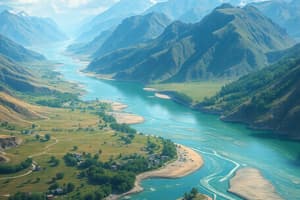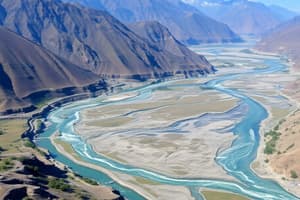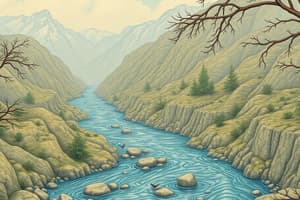Podcast
Questions and Answers
What does the term drainage describe?
What does the term drainage describe?
The river system of an area.
Which of the following are the two major groups of Indian rivers?
Which of the following are the two major groups of Indian rivers?
- Western rivers
- Himalayan rivers (correct)
- Peninsular rivers (correct)
- Northern rivers
What is a drainage basin?
What is a drainage basin?
The area drained by a single river system.
All Himalayan rivers are perennial.
All Himalayan rivers are perennial.
What separates two drainage basins?
What separates two drainage basins?
Which two major Himalayan rivers originate north of the mountain ranges?
Which two major Himalayan rivers originate north of the mountain ranges?
What drainage pattern develops where the river channel follows the slope of the terrain?
What drainage pattern develops where the river channel follows the slope of the terrain?
What is the world's largest drainage basin?
What is the world's largest drainage basin?
Which direction do most rivers of peninsular India flow?
Which direction do most rivers of peninsular India flow?
Which of the following rivers are considered major Himalayan rivers?
Which of the following rivers are considered major Himalayan rivers?
Flashcards are hidden until you start studying
Study Notes
Drainage
- Drainage describes the river system of a geographic area.
- A drainage basin is the area drained by a single river system.
- An elevated area separating two drainage basins is called a water divide.
- The Amazon River has the largest drainage basin in the world.
Drainage systems in India
- India's drainage systems are shaped by its diverse relief features, with major groups being the Himalayan rivers and the Peninsular rivers.
- Himalayan rivers are perennial, meaning they have water throughout the year.
- These rivers receive water from rain and melted snow from the Himalayas.
- The Indus and Brahmaputra rivers originate in the north of the Himalayas.
- Himalayan rivers have long courses, forming gorges in the upper reaches and displaying significant erosional activity.
- Himalayan rivers form meanders, oxbow lakes, and floodplains in the middle and lower courses.
- They also have well-developed deltas.
- Peninsular rivers are generally shallower than their Himalayan counterparts.
- Some Peninsular rivers originate in the central highlands and flow westward.
- Many Peninsular rivers originate in the Western Ghats and flow eastward towards the Bay of Bengal.
Major Himalayan rivers
- The major Himalayan rivers are the Indus, the Ganga, and the Brahmaputra.
Drainage Patterns
- Drainage patterns within a basin are influenced by land slope, underlying rock structure, and climate.
- Dendritic pattern resembles a tree's branches and develops in areas with uniform rock and slope.
- Trellis pattern develops where hard and soft rocks exist parallel to each other, with tributaries joining the main river at right angles.
- Rectangular pattern develops in strongly jointed rocky terrains.
- Radial pattern occurs when streams flow out from a central peak or dome.
- Combinations of several drainage patterns may be present in a single basin.
Figure 3.2: A Gorge
- A gorge is a narrow, steep-sided valley formed by the erosive power of a river cutting through a mountain range.
Figure 3.3: A Delta
- A delta is a landform created at the mouth of a river where it meets a larger body of water.
- It is formed by the deposition of sediment carried downstream by the river.
Studying That Suits You
Use AI to generate personalized quizzes and flashcards to suit your learning preferences.




